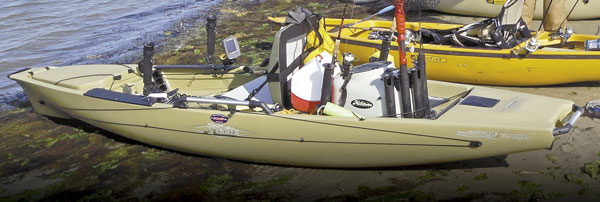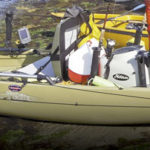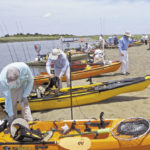
With the popularity of kayak-fishing growing by leaps and bounds, it’s time to offer some advice about fishing safety and equipment that is required or should be carried while fishing from a kayak.
Fishing from a kayak is fun and allows fishermen to explore waters, some of which may not even be available to the shallowest of technical poling skiffs. On the extreme end, adventurous fishermen are hitching rides offshore on larger boats and then launching to do battle with billfish, tuna, wahoo, sharks and other denizens of the deep. With the freedom to explore, fishermen in the plastic navy should follow some steps as they venture out in their piscatorial pursuits.
Basic safety is foremost. If nothing else sinks in, understand that a personal floatation device (PFD) is required, and it doesn’t do much good if it isn’t being worn. Youngsters under 13 are required by law to wear a PFD. In a kayak, everyone should wear one.
There are many kinds of PFDs, and having one that is comfortable is the key to wearing it. Fishermen like a lot of pockets to store things, and most PFDs designed for anglers have them. Inflatable PFDs are the least bulky and typically are very comfortable. They also allow more air to pass to the fishermen, which helps keep them cool in hot conditions. Inflatable PFDs are not available in all kayak shops. Major catalogs and some manufacturers off their websites. They are often available at tackle shops.
A whistle or some kind of audible signaling device is also required. Whistles range from a basic lifeguard or referee whistle to complex models with storage compartments, signal mirrors and compasses built in. Find one you like and carry it. Some kayakers like to wear their whistle on a lanyard or attach it to their vest, while many fishermen store it in a pocket to avoid tangling with fishing lines and such. The key is having and carrying it.
Numerous opinions and arguments abound regarding lights on a kayak. The law states that paddle-powered vessels less than seven meters (23 feet) operating at night may use the lights designated for sailboats, but must have at a minimum a white light ready and available to be displayed in time to avoid a collision. The law does not state that this light must be on board during the daytime, but it requires it in times of limited visibility. As we live in a state where fog and downpour rainfall are common occurrences, it is wise to have a light on board at all times.
Several companies, including Yak Attack (www.yakattack.us) offer lights that are mounted on lightweight flag poles, increasing daytime visibility in their own right — and increased visibility while on a kayak is a good thing. You can find these accessories at most kayak shops. I like the light weight and easy storage feature of the Yak Attack VISICarbonPro, which combines a 2 NM light, an orange flag, and a 4-section flagpole that all breaks down and stores in a pocket on the flag. More flagpole sections are available to raise the flag and light.
Communication is important for kayak fishermen. Many fishermen rely on their cell phones, but we all know about dropped calls, phones dropped overboard, dead spots and other reasons cell phones are not 100-percent reliable. Hand-held marine radios have become much smaller in recent years, and many models are available that are waterproof, with some also having Global Positioning System (GPS) location and navigation capabilities. You can usually reach a boater or the Coast Guard on a marine VHF radio. It would also be wise to know a few basic paddle signals. The American Canoe Association (www.americancanoe.org) offers this and more.
When carrying electronic equipment, it is of utmost importance to have a way to keep it dry. If it gets wet and quits working, it suddenly becomes expensive junk. Seattle Sports (www.seattlesportsco.com) is one of several companies that make waterproof cases for cell phones, cameras, iPods and such. The Dry Doc line of waterproof vinyl cases include lanyards and straps for holding them right where you want them, like on the shoulder strap of a PFD, and allow talking and phone operation through the vinyl without having to expose the phone to water. Dry bags will keep larger equipment dry.
Leashes and tethers are as important as keeping things dry. The question of an untimely exit from a kayak is one of when, not if. If you kayak long enough, you will take a dunking. You may also lose things that fall out without turning over. It is very wise to use a leash or tether on anything you cannot live without. Even if your equipment floats, it may get washed away if it isn’t leashed. My suggestion is to leash your paddle, then your fishing rods, and the priority from there is personal.
Making a float plan and leaving it with family or a friend is more important with a kayak than with a boat. It doesn’t matter if you are making a float from Point A to Point B, or planning to return to the launch site, someone needs to know where you were going, how you were planning to go, the color(s) of your kayak(s), what vehicle you were driving and when you planned to return. This information is important during the summer, but it could be the difference between survival and not once the water and weather cools.
It is not wise to kayak fish alone. We probably all do it at some time, but fishing with a buddy is far safer. That gives you someone to help with difficult situations and some one can contact or go for help if needed.
Proper clothing is a must for kayaking. With so many modern advances in materials, it’s possible to have clothing that is sun-protective, yet helps keep you cool. My favorites are the shirts, with attached sun masks, from Breathe Like A Fish (www.breathelikeafish.com). I also wear zip-off long pants and a long bill cap. Conversely, cool- and cold-weather gear is a must when kayaking then.
Using unscreen and staying hydrated while fishing are important, too. Use a high SPF-rated sunscreen, because you will get busy and forget to reapply it. If you wear shorts, be sure to coat the inside of your thighs with sunscreen. They tend to burn badly. Water is the best liquid for staying hydrated. If you can’t handle it straight, there are numerous flavor packs available, including some with protein for a little energy boost.
I know this sounds like a lot, but it really isn’t. Make a checklist and follow it. Make being safe and properly prepared a habit and it will stick with you. Being in a picture while smiling and holding a big fish is a much better adventure than wondering if you can get back in or if someone will be able to find you.






Be the first to comment